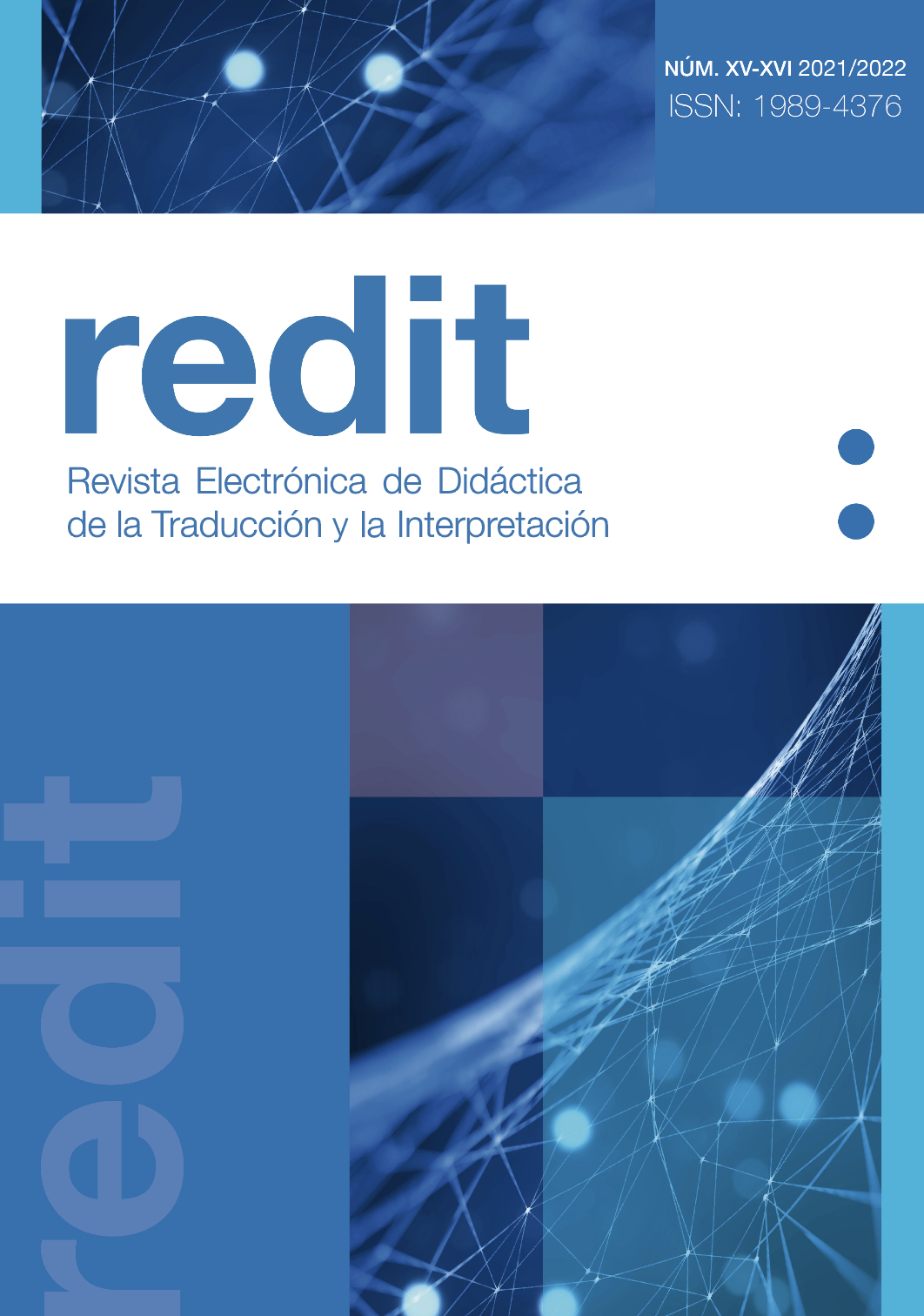Didactics and assessment in interpreting: self-assessment, peer assessment, and expert assessment
DOI:
https://doi.org/10.24310/redit.18.2024.19822Keywords:
assessment, interpreting trainingAbstract
This article is a preliminary proposal of an assessment model for conference interpreting (both simultaneous and consecutive) coming from the experience of the Department of Interpreting and Translation (DIT) at the University of Bologna and, more specifically, from the best practices emerging from teaching support (exercise hours) and extra-curriculum (tutorials) activities of conference interpreting between Italian and Spanish. However, these best practices may be applied to any language combination. The model is based upon three phases: self-assessment, peer assessment and expert assessment. The second part of this article describes the implementation modalities and the methods of this approach at DIT. To conclude, this article sheds lights on some potential investigation developments.
Downloads
Metrics
References
Ackermann D, H. Lenk y M. Redmond 1997. “Between Three Stools - Performance Assessment in Interpreter Training”. En Fleischmann, Eberhard, Wladimir Kutz y Peter Axel Schmitt (eds.) Translationsdidaktik. Grundfragen der Übersetzungswissenschaft. Proceedings of a conference held in Leipzig in September, Tübingen: Gunten Narr, 262–268.
Barik H. C. 1975. “Simultaneous Interpretation: Qualitative and Linguistic Data”. En Language and Speech, 18(3): 272-297.
Bartlomiejczyk M., 2007, “Interpreting Quality as Perceived by Trainee Interpreters”. En The Interpreter and Translator Trainer, 1(2): 247-267.
Bendazzoli C. 2010a. Corpora e interpretazione simultanea. Bologna: Asterisco.
Bendazzoli C. 2010b. Il corpus DIRSI: creazione e sviluppo di un corpus elettronico per lo studio della direzionalità in interpretazione simultanea. Tesis de doctorado. Universidad de Bologna.
Cokely D. y E. Winston 2008. “Phase I Deaf Consumer Needs Assessment Final Report, Report submitted on behalf of the National Consortium of Interpreter Education Centers”. Informe electrónico. URL: http://www.interpretereducation.org/wp-content/uploads/2011/06/FinalPhaseIDCReport.pdf [consulta: 10/05/2024]
Dillinger M. 1994. “Comprehension during interpreting. What do interpreters know that bilinguals don’t?”. En Lambert, Sylvie y Barbara Moser-Mercer (eds.) Bridging the Gap: Empirical research in simultaneous interpretation, Amsterdam and Philadelphia: John Benjamins 155-190.
Falbo C. 1998. “Analyse des erreurs en interprétation simultanée”. En The Interpreter’s Newsletter, 8: 107-120.
Falbo C. 2018. “Insegnare la simultanea dal francese all’italiano. La prosodia come rivelatore dell'apprendimento”. En InTralinea Special Issue 2018, Revista electrónica [consulta: 10/05/2024]
Foster L. y A. Cupido 2017. “Assessing spoken-language educational interpreting: Measuring up and measuring right”. En Stellenbosch Papers in Linguistics Plus, 53: 119-132.
Frabetti F. 2005. Fenomeni di mitigazione nel discorso interpretato. Tesis de posgrado no publicada, Universidad de Bolonia.
Garzone G. 2022. “Quality and Norms in Interpretation”. En Garzone, Giuliana y Maurizio Viezzi (eds.), Interpreting in the 21st century, Amsterdam: John Benjamins, 107-119.
Kalina S. 2005. “Quality in the interpreting process: what can be measured and how?”. En Godijns, Rita M. y Michaël Hinderdael (eds.), Directionality in Interpreting. The 'Retour' or the Native?, Gent: Communication & Cognition, 27-46.
Kopczynski A. 1980. Conference interpreting: some linguistics and communicative problems. Poznan: UAM.
Kruger J. y D. Dunning 1999. “Unskilled and unaware of it: how difficulties in recognizing one’s own incompetence lead to inflated self-assessment”. En Journal of Personality and Social Psychology, 77(6): 1121-1134.
Kurz I. 2001. “Conference Interpreting. Quality in the Ears of the User” En Meta, 46(2), 394-409.
Luque Nadal L. 2009. “Los culturemas: ¿unidades lingüísticas, ideológicas o culturales?”. En Language Design, 11: 93-120.
Moser-Mercer B. 2008. “Constructing Quality Interpretation”. En Hansen, Gyde, Andrew Chesterman y Heidrun Gerzymisch-Arbogast (es.), Efforts and Models in Interpreting and Translation Research. A Tribute to Daniel Gile, Amsterdam: John Benjamins, 143-156.
Pöchhacker F. 1994. “Quality assurance in simultaneous interpreting”. En Dollerup, Cay y Annette Lindegaard (eds.), Teaching Translation and Interpreting 2: Insights Aims and Visions, Amsterdam: John Benjamins, 155-189.
Riccardi A. 2002. “Evaluation in Interpretation: Macrocriteria and Microcriteria”. En Hung, Eva (ed.), Teaching Translation and Interpreting 4. Building Bridges, Amsterdam: John Benjamins, 115-126.
Russo M. 1995. “Self-evaluation: the awareness of one's own difficulties as a training tool for simultaneous interpretation”. En The Interpreter’s Newsletter, 6: 75-86.
Russo M. 2014. “Fenomeni dell’oralità critici per l’interpretazione simultanea”. En Cuadernos AISPI, 4: 165-182.
Sandrelli A. 2012. “Interpreting football press conferences: the FOOTIE Corpus”. En Kellet Bidoli, Cynthia Jane (ed.), Interpreting across genres: Multiple research perspectives, Trieste: EUT, 78-101.
Schjoldager A. 1996. “Assessment of Simultaneous Interpreting”. En Dollerup, Cay y Vibeke Appel (eds.), Teaching Translation and Interpreting 3. New Horizons, Amsterdam: John Benjamins, 187-196.
Schafer T. 2011, “Developing expertise through a deliberate practice project”. En International Journal of Interpreter Education, 3, Revista electrónica. [consulta: 10/05/2024]
Shlesinger M. 1994. “Intonation in the Production and Perception of Simultaneous Interpretation”. En Lambert, Sylvie y Barbara Moser-Mercer (eds.), Bridging the Gap: Empirical research in simultaneous interpretation, Amsterdam: John Benjamins, 225-236.
Downloads
Published
How to Cite
Issue
Section
License

Este obra está bajo una licencia de Creative Commons Reconocimiento-NoComercial-SinObraDerivada 4.0 Internacional.






29.png)
